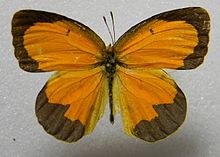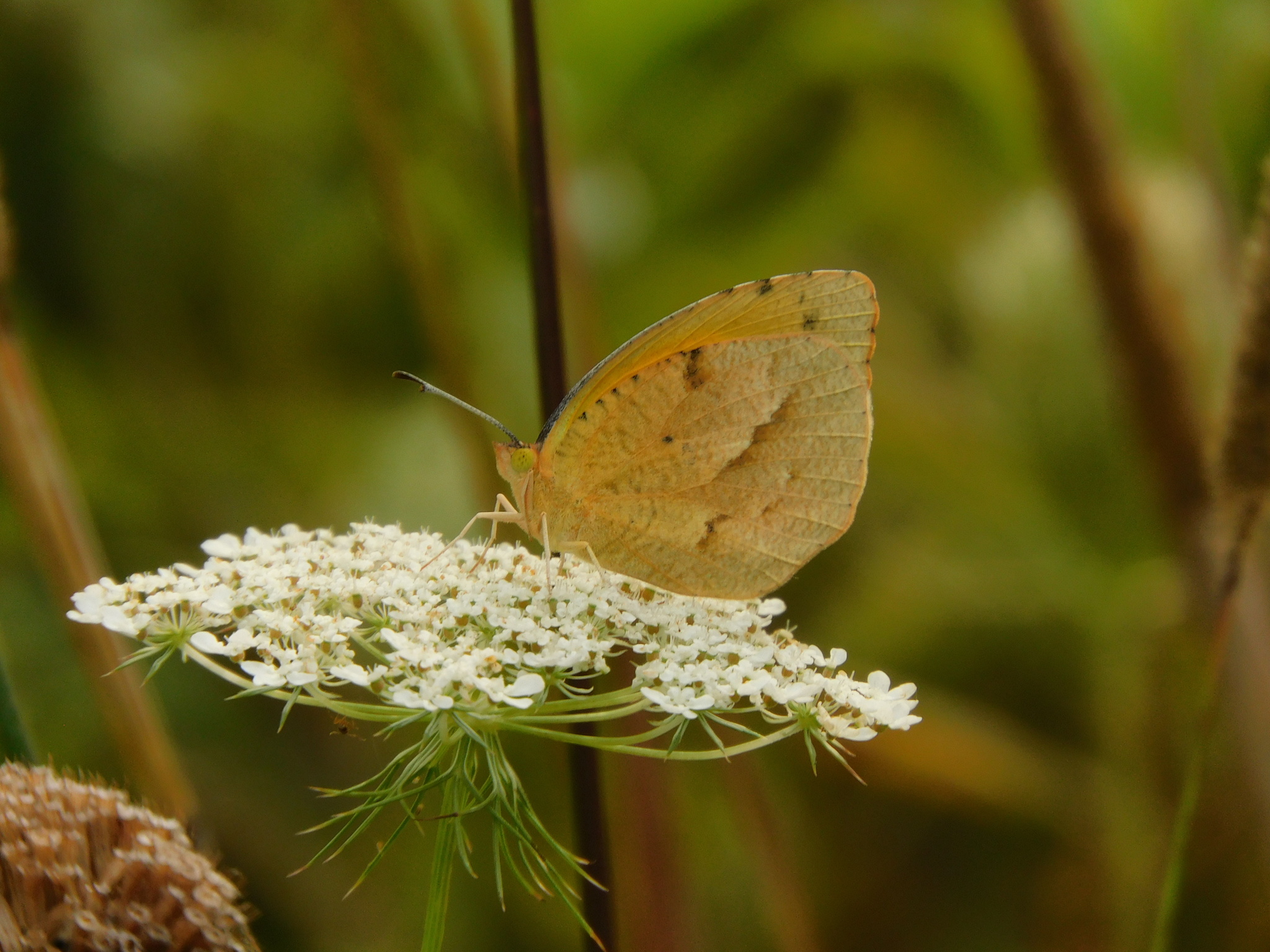Map Snapshot

























547 Records
Status
Sleepy Orange (Abaeis nicippe) is yet another southern species prone to wandering into Maryland in late summer. This butterfly normally occurs from June or July into September, and even may be uncommon at times. While it may oviposit, the caterpillars are thought to not survive the winters (Butterflies of Maryland: A Biological Summary and Checklist by Lynn Davidson & Richard Smith; Brock & Kaufman 2003).
Relationships
Sleepy Orange uses Partridge Pea (Chamaecrista fasciculata) and American Senna (Senna hebecarpa), which occur widely, but it may not be able to survive the harsher winter temperatures.
Seasonality Snapshot
Source: Wikipedia
| Sleepy orange | |
|---|---|

| |

| |
| Scientific classification | |
| Domain: | Eukaryota |
| Kingdom: | Animalia |
| Phylum: | Arthropoda |
| Class: | Insecta |
| Order: | Lepidoptera |
| Family: | Pieridae |
| Genus: | Eurema |
| Species: | E. nicippe
|
| Binomial name | |
| Eurema nicippe (Cramer, 1779)
| |
| Synonyms | |
| |
Eurema nicippe, the sleepy orange, is a North American butterfly in the family Pieridae. Its range spans from Central America to north along the United States-Mexico border, and it often travels further to non-mountainous regions of the southeastern United States.[3]
Description
[edit]
The sleepy orange is a bright orange butterfly with the upperside of the wings having wide black borders. The forewing costal margin has a small, narrow black marking that resembles a closed eye. Contrary to popular belief, its name originates from this wing patterning, rather than its behavior; the butterfly has a very rapid flight pattern when disturbed.[4] The underside of the wings varies seasonally: summer forms are bright yellow with brick-red markings, while winter forms are browner and more heavily marked. It has a wingspan of 13⁄8–21⁄4 inches (35–50 mm).[5]
Habitat
[edit]The sleepy orange generally prefers low elevation areas,[3] agricultural land, and disturbed sites,[5] and may be found in or around old fields, roadsides, woods edges, swamps, wet meadows, open woodlands, margins of ponds, waterways, and valleys.[4]
Life cycle
[edit]Its eggs are spindle-shaped and white in color when first laid, but quickly turn yellow.[4] They are laid on the underside of the leaves of its host plant, often members of the legume family.[6] The larva is pale green with a narrow white stripe along its length on either side and very short hairs.[4] The chrysalis varies from pale green[7] to brown-black later in its life cycle.[5] They have two to four broods per year. They can be found year-round further south, but migrate north during the warmer summer months.[8]
Host plants
[edit]- Partridge pea, Chamaecrista fasciculata
- Wild sensitive plant, Chamaecrista nictitans
- Senna hebecarpa
- Privet senna, Senna ligustrina
- Senna marilandica
- Senna mexicana
- Senna obtusifolia
Similar species
[edit]- Colias eurytheme - orange sulphur
- Eurema proterpia - tailed orange
References
[edit]- ^ Walker, A. (2020). "Abaeis nicippe". IUCN Red List of Threatened Species. 2020: e.T173005000A173005029. doi:10.2305/IUCN.UK.2020-3.RLTS.T173005000A173005029.en. Retrieved 6 December 2022.
- ^ "NatureServe Explorer 2.0 Abaeis nicippe Sleepy Orange". explorer.natureserve.org. Retrieved 3 October 2020.
- ^ a b "Sleepy Orange Abaeis nicippe (Cramer, 1779)". Butterflies and Moths of North America. June 10, 2024. Retrieved June 10, 2024.
- ^ a b c d "Sleepy Orange". Alabama Butterfly Atlas. June 10, 2024. Retrieved June 10, 2024.
- ^ a b c "Florida's Wildflowers & Butterflies | Sleepy Orange". Florida Museum of Natural History. Retrieved 2024-06-10.
- ^ "Sleepy Orange - Pollinator Web". 2023-04-14. Retrieved 2024-06-10.
- ^ Krotzer, Steve and Mary Jane. "Sleepy Orange". Haysop Hill Photography. Retrieved June 10, 2024.
- ^ Webmaster, David Ratz. "Sleepy Orange - Montana Field Guide". fieldguide.mt.gov. Retrieved 2024-06-10.
- Jim P. Brock, Kenn Kaufman (2003). Butterflies of North America. Boston: Houghton Mifflin. ISBN 0-618-15312-8.
- James A. Scott (1986). The Butterflies of North America. Stanford University Press, Stanford, California. ISBN 0-8047-2013-4
- Ernest M. Shull (1987). The Butterflies of Indiana. Indiana Academy of Science. ISBN 0-253-31292-2
- Rick Cech and Guy Tudor (2005). Butterflies of the East Coast. Princeton University Press, Princeton, New Jersey. ISBN 0-691-09055-6
- David L. Wagner (2005). Caterpillars of Eastern North America. Princeton University Press, Princeton, New Jersey. ISBN 0-691-12143-5

































